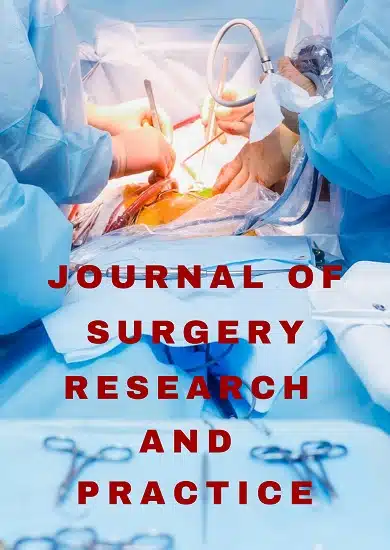Case Report | Vol. 6, Issue 1 | Journal of Surgery Research and Practice | Open Access |
Upper Intestinal Obstruction as a Late Complication of Fobi Capella Surgery: A Case Report
Penedo LD1, Madureira FAV2, Garritano C3*, Andrade DM2, Manso JP4
1Student of the Professional Master’s Course, Federal University of the State of Rio de Janeiro, Brazil
2Department of General Surgery, Federal University of the State of Rio de Janeiro, Brazil
3Full Professor of Surgical Clinic A, Department of General Surgery, Federal University of the State of Rio de Janeiro, Brazil
4Department of General Surgery, Salgado Filho Municipal Hospital, Brazil
*Correspondence author: Célia Garritano, Full Professor of Surgical Clinic A, Department of General Surgery, Federal University of the State of Rio de Janeiro, Brazil; Email: [email protected]
Citation: Penedo LD, et al. Upper Intestinal Obstruction as a Late Complication of Fobi Capella Surgery: A Case Report. J Surg Res Prac. 2025;6(1):1-6.
Copyright© 2025 by Penedo LD, et al. All rights reserved. This is an open access article distributed under the terms of the Creative Commons Attribution License, which permits unrestricted use, distribution, and reproduction in any medium, provided the original author and source are credited.
| Received 07 April, 2025 | Accepted 22 April, 2025 | Published 29 April, 2025 |
Abstract
Obesity is one of the most prevalent chronic conditions today, representing a significant public health problem. Conservative measures, strict diet and physical activity rarely achieve a good result, while bariatric surgery has become the treatment of choice for cases of morbid obesity, showing encouraging results. Several techniques have emerged that have proven effective, which have presented late complications, requiring a new surgical approach.
Keywords: Bariatric Surgery; Morbid Obesity; Annulus Migration
Introduction
Obesity is recognized as a public health problem and responsible for the triggering of several metabolic diseases [1]. The development of effective therapeutic approaches is essential for the management of obesity, especially in cases of morbid obesity, where conservative measures such as diet and physical activity often show limited results.
Bariatric surgery has established itself as the most effective treatment to provide significant and sustained weight loss, with a proven reduction in mortality related to conditions associated with obesity [2].
Among the most used techniques, the Roux-en-Y gastric bypass stands out, that combines gastric restriction and changes in intestinal absorption and is often incorporated into the use of the gastric ring, whose function is to limit ingestion capacity and delay gastric emptying, intensifying satiety and optimizing weight loss results [3]. Despite its efficacy, this surgery is not without risks, particularly with late complications, which include annulus migration, erosion, gastroenteroanastomosis stenosis and upper intestinal obstruction [4].
We present a case of complication of Roux-en-Y gastric bypass due to stenosis of the gastroenteroanastomosis due to gastric ring migration 20 years after primary surgery.
Case Presentation
A 65-year-old female patient underwent laparotomy gastric bypass with a Roux-en-Y gastric ring in 2000 for the treatment of morbid obesity. After more than two decades of the procedure, the patient presented a progressive clinical picture, characterized by nausea, vomiting and hyporexia, in addition to a reduction in the elimination of feces and flatus. She also reported a history of four episodes of pneumonia in the previous year, a fact that raised suspicions of a possible obstructive condition, complicated by recurrent bronchopulmonary aspiration.
An abdominal computed tomography scan showed significant dilation of the esophagus and gastric pouch, compatible with downstream functional obstruction, located in the region of the gastric ring, suggesting the presence of fibrosis stenosis, generating partial obstruction. No signs of ischemia or perforation were identified (Fig. 1,2).
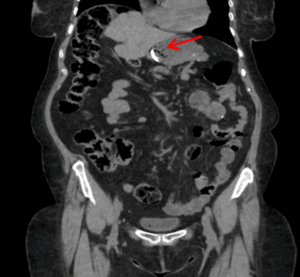
Figure 1: Gastric ring (red arrow) in gastroenteroanastomosis topography and gastric pouch dilation upstream.
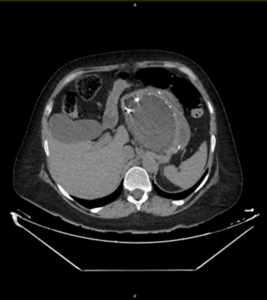
Figure 2: Voluminous esophageal and gastric pouch dilation.
Upper gastrointestinal endoscopy was performed, which confirmed a residual gastric stump of 5 cm in length, with annular constriction adjacent to the gastrojejunal anastomosis. Significant fibrosis was identified around the gastric ring, which restricted the passage of food but allowed the endoscopic device to pass through, indicating a functional stenosis without total obliteration of the lumen.
Due to the severity of the condition and the fragile nutritional status of the patient, a conservative approach was initially chosen for clinical stabilization.
The patient was hospitalized and the enteral feeding was initiated as preoperative preparation. Nutritional supplements were administered and intensive metabolic monitoring was performed to optimize clinical conditions. After two weeks, there was an improvement in the general condition and the patient was considered suitable for the surgical procedure.
We start with the dissection and lysis of adhesions for safe access to anatomical structures and minimizing the risk of inadvertent injury.
We identified the ring positioned in the gastroenteroanastomosis, associated with significant fibrosis, resulting in mechanical stenosis and dilatation upstream of the gastric pouch (Fig. 3).
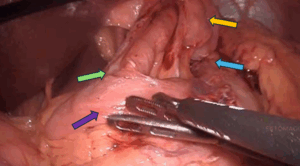
Figure 3: Excluded stomach (blue), dilated gastric pouch (orange), gastroenteroanastomosis with ennosis through the gastric band (green) and feeding loop (purple).
Next, the ring was carefully dissected and removed, correcting the stenosis (Fig. 4).
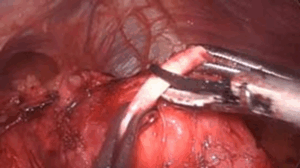
Figure 4: Gastric ring removal.
We completed the procedure by performing a sleeve gastrectomy of the gastric pouch using a linear endostapler (Fig. 5).
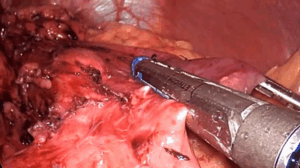
Figure 5: Vertical stapling of the gastric pouch.
To evaluate the patency of the gastroenteroanastomosis performed, we injected methylene blue dye through the Fouchet probe and no signs of extravasation were observed, confirming the anatomical integrity.
The patient had a good evolution in the immediate postoperative period and a liquid diet was started on the first day after surgery, with good tolerance. She was released for hospital discharge on the third postoperative day with guidelines for outpatient follow-up and gradual progression of the diet. At outpatient follow-up, the patient reported complete resolution of previous symptoms and good tolerance to the progression of the oral diet. Return to stable weight and recovery of quality of life were observed as positive outcomes. There was no recurrence of symptoms or associated complications during the follow-up period.
Discussion
Late complications of bariatric surgery represent one of the greatest challenges faced by general and bariatric surgeons, especially in cases of gastric Y bypass with gastric ring. Although recognized for its effectiveness in reducing weight and controlling metabolic comorbidities, it is associated with anatomical and functional changes that can lead to complications years after the initial procedure [1].
Ring migration and stenosis represent a small portion of cases of late complications, ranging between 1% and 2% and are more frequently associated with the use of restrictive devices, but potentially severe [13]. Its pathophysiology involves inflammatory and scarring processes that, in the long term, can result in fibrosis and narrowing of the intestinal lumen [4].
In the case reported here, the patient presented persistent nausea and postprandial vomiting, which compromised food intake, in addition to 4 episodes of pneumonia, possibly bronchoaspiration, in 1 year. These symptoms, often confused with other gastrointestinal conditions such as reflux or food intolerance, emphasize the importance of a detailed evaluation in bariatric patients with chronic complaints.
We emphasize that the preoperative period was essential for an adequate investigation and preparation of the patient for the surgical procedure. The diagnosis of stenosis was made possible by the combination of imaging methods and upper gastrointestinal endoscopy, which are considered the gold standard for anatomical and functional evaluation in patients with altered anatomy [6]. Computed tomography revealed dilatation upstream of the gastric pouch and stenosis in the topography of the gastroenteroanastomosis, whereas UGIE allowed direct visualization of the annular constriction associated with fibrosis and also the passage of a nasoenteral tube for adequate preoperative nutrition.
Surgical reapproach was performed due to the severity of the obstruction and the failure of conservative management to resolve symptoms completely. This type of intervention presents significant technical challenges, including extensive adhesions and fibrosis around the gastric ring [7]. In the case described, adhesion lysis was essential to allow safe access to the affected structures, reducing the risk of inadvertent injury to adjacent organs.
The removal of the gastric ring, a critical step of the procedure, required careful dissection to avoid injuries to the anastomosis. The decision to remodel the gastric pouch utilizing sleeve gastrectomy was based on evidence that points to an improvement in gastric functionality and food tolerance after this intervention [11]. It was decided not to construct a new gastroenteroanastomosis, due to the intraoperative conclusion that the obstruction was due to extrinsic compression promoted by the gastric ring associated with many adhesions, which were withdrawals. The methylene blue test was used to ensure that the anastomosis was patent and the absence of extravasation, corroborating the safety of the procedure [12-15].
Conclusion
The surgical approach of the present case is in line with the best practices described in the literature, which emphasize the importance of meticulous technique and individualized decisions. Procedures such as adhesion lysis and gastric remodeling are widely accepted as effective strategies to treat complex strictures, especially in patients with severe fibrosis and significant proximal dilation. These data reinforce the importance of long-term monitoring and additional prospective studies to investigate the specific risk factors associated with gastroenteroanastomosis stenosis, including patient characteristics and best surgical techniques for managing these complications.
Conflict of Interest
The authors declare that there is no conflict of interest.
Free and Informed Consent Term
The patient authorized the publication of the article.
Availability of Data and Materials
Data is custodied by the author and can be released on trust.
Funding
No funding from any institution or organization.
References
- Angrisani L, Santonicola A, Iovino P, Formisano G, Buchwald H, Scopinaro N. Bariatric surgery worldwide 2013. Obesity Surgery. 2015;25:1822-32.
- Buchwald H, Oien DM. Metabolic/bariatric surgery worldwide 2011. Obesity Surgery. 2013;23:427-36.
- Shikora SA, Kim JJ, Tarnoff ME. Nutrition and Surgical Considerations After Bariatric Surgery. The American Journal of Clinical Nutrition. 2005;82(1):245S-8S.
- Nguyen NT, Varela JE, Sabio A. Complications of adjustable gastric banding: Management and outcomes. Obesity Surgery. 2006;16(10):1260-6.
- Garcia A, da Silva MJ, Kondo W. Late complications of bariatric surgery: How to manage them? Arquivos Brasileiros de Cirurgia Digestiva. 2020;33(4):e1536.
- Lobstein T, Brinsden H, Landon J, Kraak V, Musicus A, Macmullan J. INFORMAS and advocacy for public health nutrition and obesity prevention. Obesity Reviews. 2013;14.
- Higa K, Ho T, Boone K. Complications of the Fobi-Pouch gastric by-pass: The importance of follow-up and surgical revision. Obesity Surgery. 2001;11(2):190-5.
- Rubino F, Nathan DM, Eckel RH, Schauer PR, Alberti KG, Zimmet PZ, et al. Metabolic surgery in the treatment algorithm for type 2 diabetes: A joint statement by international diabetes organizations. Diabetes Care. 2016;39(6):861-77.
- Sørensen LT. Complications of surgery in relation to BMI. Obesity Surgery. 2012;22(5):764-71.
- Sapin E, Galvao-Neto MP. Endoscopic management of bariatric complications: An update. World J Gastrointestinal Endoscopy. 2014;6(11):693-702.
- Fobi MA, Lee H, Holness R, Cabinda DG. Gastric by-pass Operation with a silastic ring “Fobi-Pouch Gastric by-pass”. Obesity Surgery. 2001;11(2):227-31.
- Schauer PR, Bhatt DL, Kirwan JP, Wolski K, Aminian A, Brethauer SA, et al. Bariatric surgery versus intensive medical therapy for diabetes-5-year outcomes. New England J Medicine. 2017;376(7):641-51.
- Boza C, Salinas J, Barros D. Late complications after bariatric surgery: Anastomotic strictures and internal hernias. Surgical Endoscopy. 2019;33(6):1994-9.
- Himpens J, Dapri G, Cadière GB. Laparoscopic revision of bariatric surgery for complications or inadequate weight loss: Results in 41 patients. Obesity Surgery. 2016;16(10):1156-63.
- Cummings DE, Flum DR. Gastrointestinal surgery as a treatment for diabetes. JAMA. 2008;299(3):341-3.
Author Info
Penedo LD1, Madureira FAV2, Garritano C3*, Andrade DM2, Manso JP4
1Student of the Professional Master’s Course, Federal University of the State of Rio de Janeiro, Brazil
2Department of General Surgery, Federal University of the State of Rio de Janeiro, Brazil
3Full Professor of Surgical Clinic A, Department of General Surgery, Federal University of the State of Rio de Janeiro, Brazil
4Department of General Surgery, Salgado Filho Municipal Hospital, Brazil
*Correspondence author: Célia Garritano, Full Professor of Surgical Clinic A, Department of General Surgery, Federal University of the State of Rio de Janeiro, Brazil; Email: [email protected]
Copyright
Penedo LD1, Madureira FAV2, Garritano C3*, Andrade DM2, Manso JP4
1Student of the Professional Master’s Course, Federal University of the State of Rio de Janeiro, Brazil
2Department of General Surgery, Federal University of the State of Rio de Janeiro, Brazil
3Full Professor of Surgical Clinic A, Department of General Surgery, Federal University of the State of Rio de Janeiro, Brazil
4Department of General Surgery, Salgado Filho Municipal Hospital, Brazil
*Correspondence author: Célia Garritano, Full Professor of Surgical Clinic A, Department of General Surgery, Federal University of the State of Rio de Janeiro, Brazil; Email: [email protected]
Copyright© 2025 by Penedo LD, et al. All rights reserved. This is an open access article distributed under the terms of the Creative Commons Attribution License, which permits unrestricted use, distribution, and reproduction in any medium, provided the original author and source are credited.
Citation
Citation: Penedo LD, et al. Upper Intestinal Obstruction as a Late Complication of Fobi Capella Surgery: A Case Report. J Surg Res Prac. 2025;6(1):1-6.

